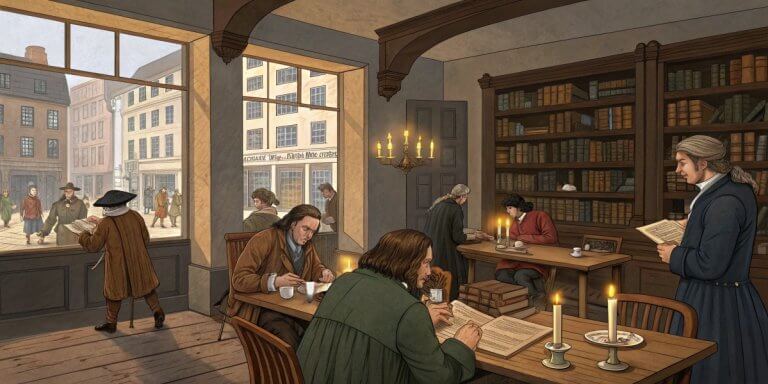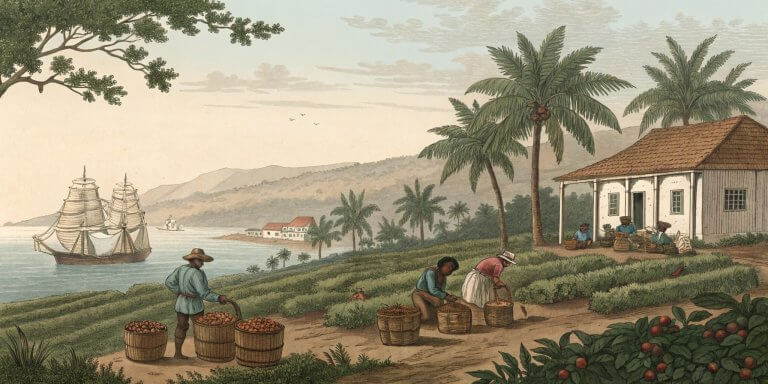
Coffeehouses, with their roots in the Middle East, have transcended national boundaries to become cultural symbols in cities worldwide. The Coffee House: A Cultural History delves into their origins and impact, showcasing how these spaces have shaped society, politics, and intellectual life across the globe. This global legacy of Coffee Houses is reflected in modern café culture, which seamlessly blends tradition with contemporary practices.
Origins of Coffeehouses in the Middle East
The history of coffeehouses began in the Ottoman Empire in the 16th century, when coffeehouses were more than just places to drink coffee. They became centers for social interaction, a break from the rigid structure of life at the time. These establishments, known as qahveh khaneh, were open to men from all walks of life. They would gather to play games, listen to music, tell stories, and drink coffee.
One of the most significant aspects of early coffeehouses was their egalitarian nature. Unlike other social spaces, coffeehouses did not discriminate by class. Seating was arranged without regard for rank, allowing merchants, scholars, and artisans to sit together and converse. This democratic space fostered intellectual exchange and even posed a potential threat to political powers. Sultan Murad IV famously tried to ban coffeehouses, fearing they would incite rebellion due to the free exchange of ideas within their walls. This inclusivity is a key part of the global coffee community, making everyone feel welcomed and part of a shared experience.
European Spread: Enlightenment and Social Change
By the mid-17th century, coffeehouses had spread to Europe, beginning in cities like Venice, London, and Paris. The introduction of coffeehouses to European society was revolutionary. These spaces quickly became hubs of intellectual discourse, earning the nickname “penny universities” in London because anyone could buy coffee and join political, science, or philosophy debates.
In London, coffeehouses were particularly significant in shaping public opinion. Merchants, journalists, and politicians gathered to discuss news and ideas, helping to foster what would eventually become the press. By the 18th century, many coffeehouse discussions had grown into full-fledged political movements, such as the French and American revolutions. Coffeehouses like Café de Procope in Paris became famous as places where revolutionaries met to exchange ideas and plan their next moves. This role in shaping public opinion is a testament to the historical significance of coffeehouses, informing readers of their impact on society.
Café Culture in America: From Diners to Coffee Bars
In the United States, café culture evolved in the 20th century, heavily influenced by European traditions and the American work ethic. The American diner, known for serving endless cups of coffee, became a cultural icon. These diners catered to the fast-paced lives of workers and travelers, offering quick service and the comforting familiarity of a “bottomless” cup of coffee.
During the 1950s and 60s, coffeehouses in cities like San Francisco and New York became gathering places for the Beat Generation, a group of writers and artists who rejected the mainstream culture of the time. These coffeehouses were simple, with wooden tables and a casual, relaxed atmosphere. Poetry readings, music, and deep discussions were common, reflecting the countercultural movement of the time.
The Global Expansion of Café Culture
As café culture spread worldwide, it adapted to local customs and traditions. For example, coffeehouses in Latin America often reflect the region’s deep-rooted coffee-growing traditions. Meanwhile, in Southeast Asia, open-air coffeehouses offer a blend of local flavors and Western influences, creating spaces unique to the region’s culture and climate. This adaptability and diversity of café culture is something to be appreciated, making readers feel more connected to the global coffee community.
Coffee’s journey from the Middle East to the Americas was also driven by colonialism. European colonial powers cultivated coffee in places like Brazil, Java, and the Caribbean, and these regions became vital to the global coffee trade. As coffee consumption grew in Europe and America, local coffeehouses became cultural touchstones, reflecting global connections and local customs.
The Third Wave Coffee Movement: A New Approach
The Third Wave coffee movement began in the early 21st century and brought a renewed focus on quality and sustainability. This movement emphasizes the craft of coffee making, sourcing beans directly from farmers, using ethical practices, and perfecting brewing techniques. Third Wave cafés often feature minimalist designs emphasizing simplicity, quality, and a focus on the coffee itself.
The Third Wave coffee movement, which began in the early 21st century, has significantly influenced café culture globally. Modern coffeehouses are no longer just places to grab a quick cup of coffee—they have become spaces where people can experience the craftsmanship behind their brew while also being conscious of their choices’ environmental and social impact. As a result, Third Wave cafés emphasize transparency, with many cafés showcasing the origin of their beans, the roasting process, and the brewing method.
Café Culture as a Space for Work and Creativity
In the modern era, coffeehouses have also become popular as workspaces. With the rise of remote work, coffeehouses have transformed into hybrid spaces where people can socialize and work. The availability of Wi-Fi, power outlets, and comfortable seating has made coffeehouses ideal for freelancers, students, and professionals who need a flexible work environment.
This evolution reflects a shift in how we view work and social spaces. Coffeehouses today are designed to accommodate solitary work and group meetings, making them versatile spaces for creativity and productivity. Many modern coffeehouses blur the line between social gathering spaces and co-working hubs, reflecting the changing nature of work in the digital age.
Cafés as Cultural Landmarks
Throughout history, iconic coffeehouses have become cultural landmarks, symbolizing the unique character of cities like Paris, Vienna, and New York. In Paris, cafés such as Café de Flore and Les Deux Magots are inseparable from the city’s intellectual and artistic history. In Vienna, coffeehouses like Café Central are gathering places for writers, artists, and thinkers.
These historic coffeehouses have preserved their architectural and cultural significance and continued to influence the identity of the cities they inhabit. They remain popular destinations for locals and tourists, offering a blend of tradition, history, and modern café culture.
Conclusion
The global legacy of coffeehouses explored in The Coffee House: A Cultural History is a testament to their enduring role in society. From the Ottoman Empire to modern-day cities, coffeehouses have evolved from simple social spaces into cultural landmarks that continue to shape how we work, socialize, and exchange ideas. Whether through the intellectual debates of Enlightenment-era Europe or the vibrant Third Wave coffee movement, coffeehouses remain central to the cultural fabric of cities worldwide. As café culture continues to evolve, it serves as a reminder of the power of these spaces to foster community, creativity, and connection.






